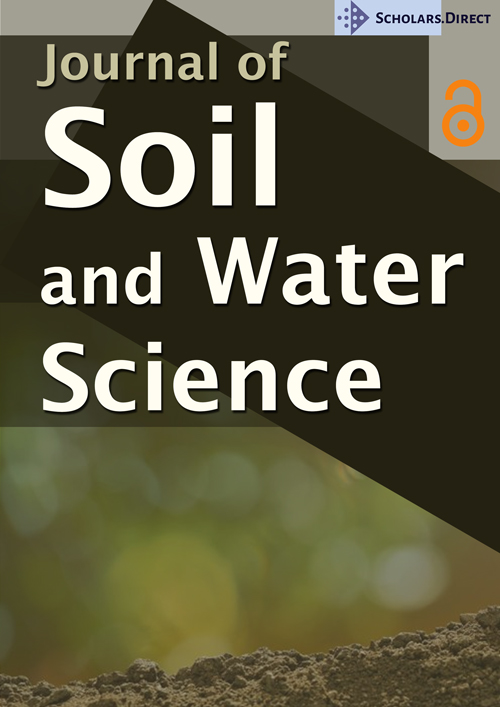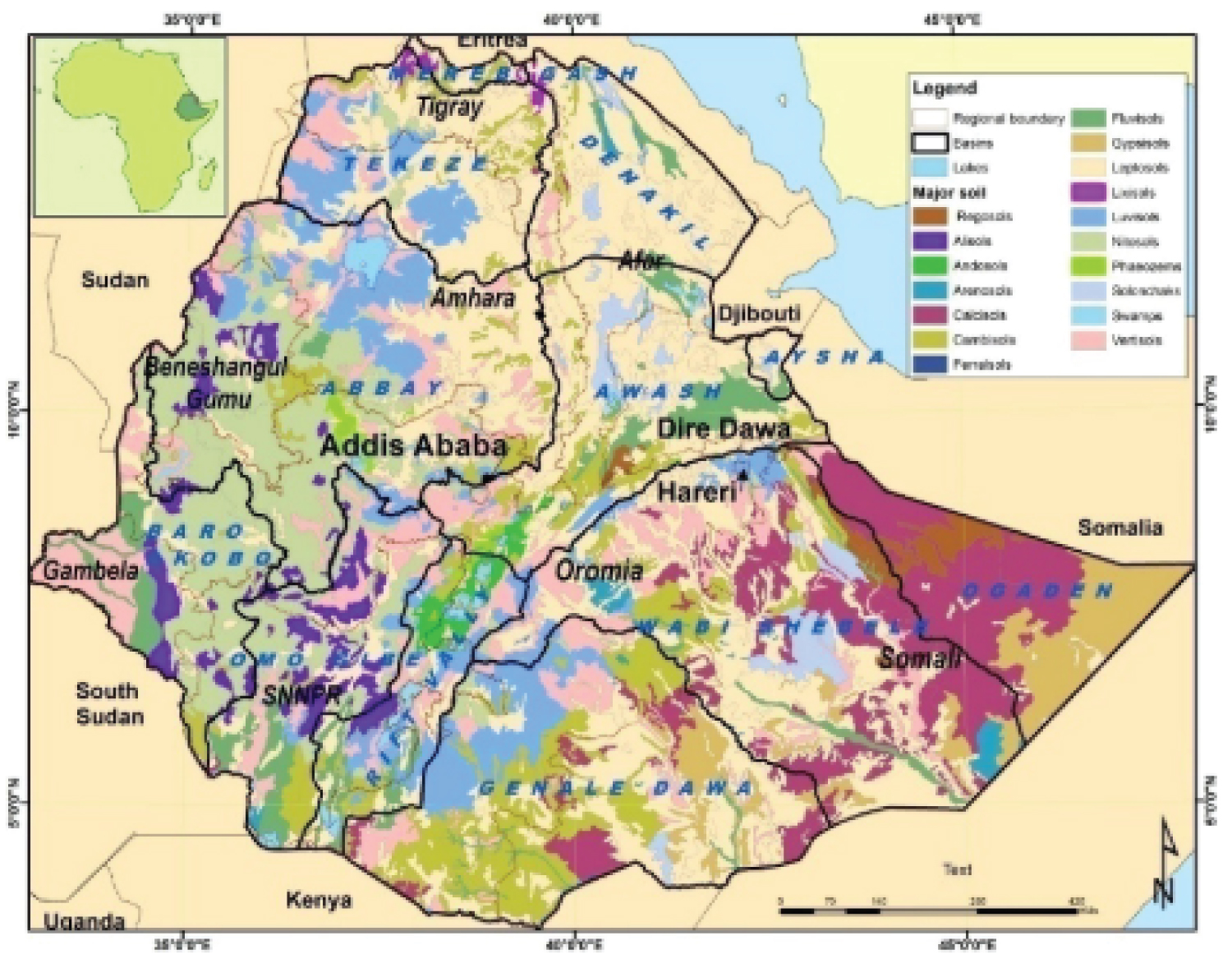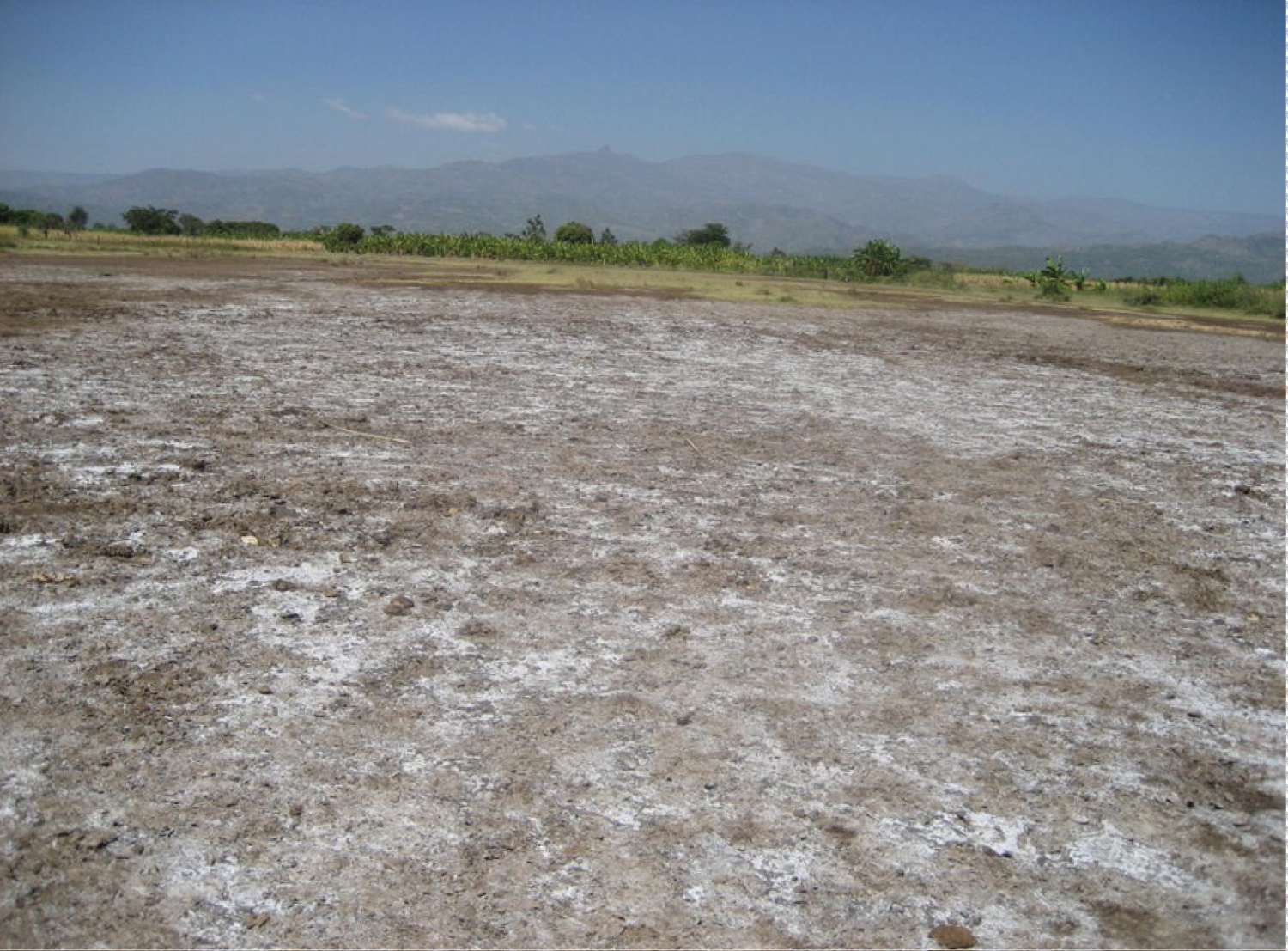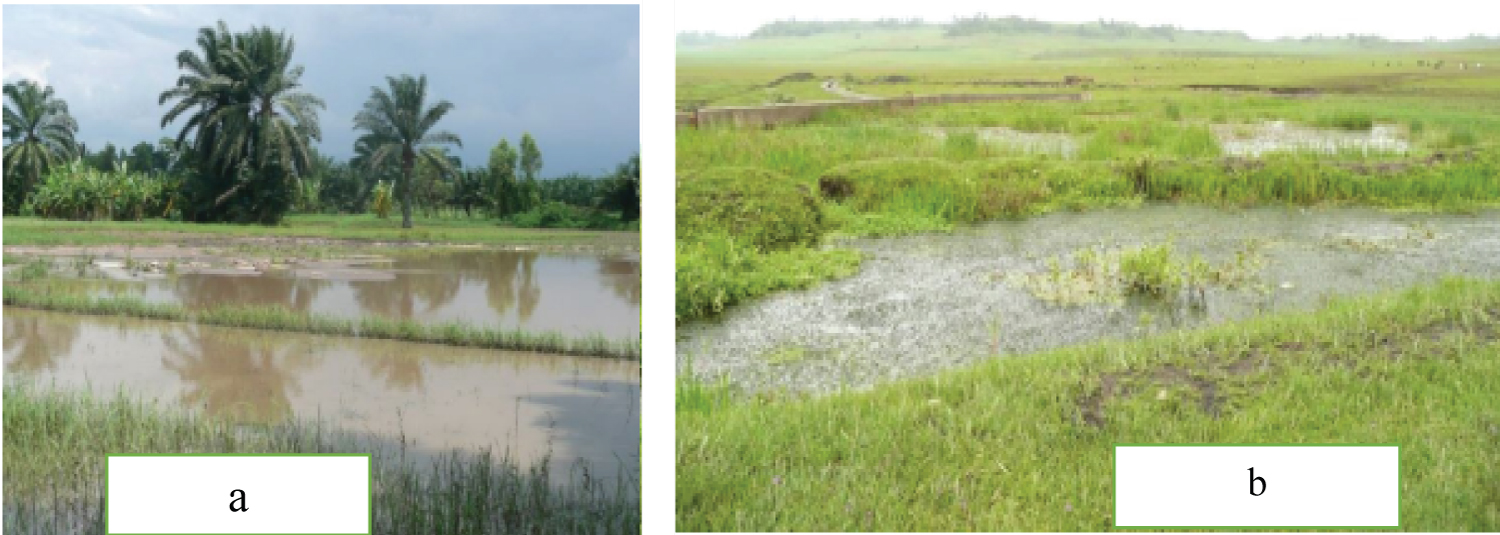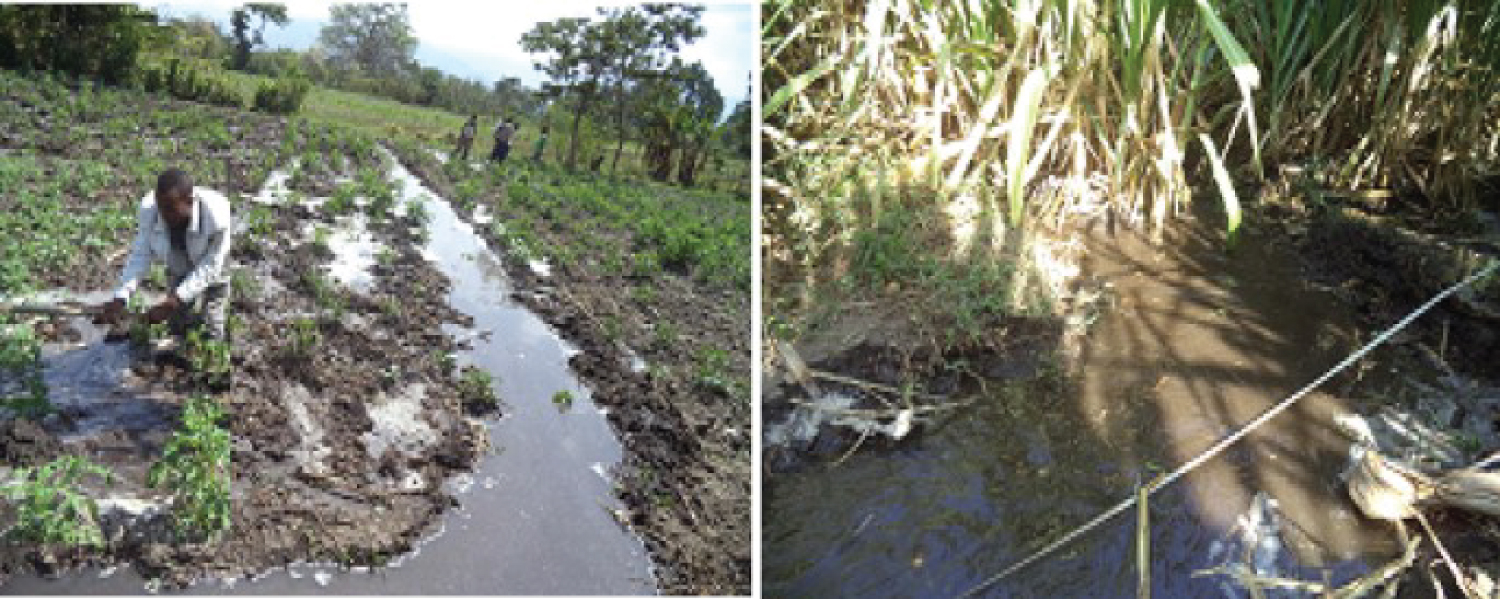Review on Baste Soil Improving Approaches for Water Logging and Soil Salinization Problems in Agricultural Land of Ethiopia
Abstract
Irrigation development is a priority taxes for agricultural transformation in Ethiopia. But poor practices of irrigation management discourage efforts to improve livelihoods and expose people and the environment to risks. In Ethiopia severe waterlogging and salinity problems have challenged agricultural production and resulted in substantially lower yields than the potential expected. So, overviewed the cause and baste approaches for management of water logging and soil salinization problems in agricultural land of Ethiopia is basic in order to get steady and reliable and well-studied documents regard to the baste soil improving approaches for water logging and soil salinization problems in agricultural land of Ethiopia. In most agricultural land of Ethiopia drainage systems is either non-existing or malfunctioning. These have significantly contributed to the frequent occurrence of waterlogging in Ethiopia along with, lack of functional drainage system and poor water management practices. As a recommendation, as most irrigation projects area in Ethiopia are become waterlogged and saline, redesign and proper management for the existing drainage system is mandatory and both salinization and waterlogging occur simultaneously or one after the other. So, drainage designer and genetic breeders should be considered both problems inseparably and fined the solution once tougher (i.e., the drainage should be used to drain both salt and waterlog once a time and the same is true for breeders).
Keywords
Agriculture, Ethiopia, Salinization and waterlogging
Introduction
According to the 2015 UN Revision, the world population of the year 2015 (7.4 billion) was expected to increase by 2.3 billion people within the next thirty years and reaching 9.7 billion in 2050 and become 11.2 billion by 2100. This population growth would inevitably pose additional demand for food [1] and the food policy of the world should serve the humanity by advancing the humane goals of eradicating extreme poverty and hunger [2].
The food policy of the world to eradicate extreme poverty and hunger have recently been challenged by emerging forces including climate change, water scarcity, the energy crisis as well as the credit crisis [2]. For These problems, development of irrigated agriculture is necessary for fulfilling the rising food requirements of the burgeoning global population [3]. However, the intensification of irrigated agriculture causes the twin menace of waterlogging and soil salinization in arid and semiarid regions of the world [3]. According to Gebrehiwot [4], this resulted significantly lower yields than the potential.
For example, according to Kasye and Melaku [5], a large portion of lands in Ethiopia is arid or semi-arid which inhabited by poor and vulnerable communities wholly dependent on rainfall agriculture and irrigation development is a priority taxes for agricultural transformation in the country. But poor practices of irrigation management discourage efforts to improve livelihoods and expose people and the environment to risks. In Ethiopia severe waterlogging and salinity problems have challenged agricultural production and resulted in substantially lower yields than the potential expected [6].
More than seven million hectares of soil in Ethiopia are vertisols, making farming is a challenge taxes in these areas, particularly during the rainy season [7]. Vertisols are clay-like soils with little organic matter that become very hard when dry and sticky and waterlogged when wet [7]. The study conducted in Sego Irrigation Farm, South Ethiopia by Zewdu, et al. [8] in order to map the soil salinity of the area from Geo-spatial approach, indicates that most of the salt affected areas were occurred in shallow water table; Cambisols and fluvisols were greatly affected by salinity; The result also, indicates that long-term irrigation activities would affect agricultural potentiality of the area in the future.
In Ethiopia, about 44 million ha (36% of the total land area) is potentially susceptible to salinity problems of which 11 million ha have already been affected by different levels of salinity and mainly concentrated in areas which have low levels of annual rainfall and high daily temperatures [9]. In line with this many irrigations project area in the country is affected by waterlogged problem. For example, according to Dinka and Ndambuki [10], about 90% of Wonji-Shoa Sugar Estate (WSSE) plantation area is affected by critical chronic waterlogging problem. In addition to this Kitila, et al. [11], also indicates that, after nearly 20-25 years of irrigation the Fincha' a Valley Sugar Estate in Ethiopia is experiencing a serious waterlogging problem (75.5% of the plantation fields are severely waterlogged and 24.5% are critically waterlogged).
For sound land use and irrigation water management, it is a paramount important to know the salinity/sodicity status of soils and irrigation water quality [12]. Because, according Fissahaye, et al. [13] in Ethiopia poor irrigation water management associated with water scarcity is the major reason for under performance of most small-scale irrigation schemes. Hence, overviewed the cause and baste approaches for management of water logging and soil salinization problems in agricultural land of Ethiopia is basic in order to get steady and reliable and well-studied documents regard to the baste soil improving approaches for water logging and soil salinization problems in agricultural land of Ethiopia.
Design of the Review
Methodology of the review
The review was investigated based on intensive reading of published and unpublished materials like books, articles and other scholarly materials that related with the objective of this review paper.
Mostly, starting from 2000 to date published literatures search was conducted through the Web of science (apps.web of knowledge.com), Google Scholar (scholar.google.com), AGRIS (agris.fao.org), Research Gate (https://www.researchgate.net), the Ethiopian Society of Soil Science (www.esss.org.et) and libraries of the Ethiopian Institute of Agricultural Research (EIAR) and National Soils Research Center.
Published articles which were mostly related with the objective of this review ware used to write this review. Publications in hard copies (research reports, articles in journals, chapter in books, proceedings and thesis were got from different institutions were also used. Focused on those reporting empirical results on water logging and soil salinization and there improving approaches were used to develop this review paper.
Questions of the review
1. What are the causes of water logging and soil salinization problems in agricultural land of Ethiopia?
2. What are the baste soil improving approaches for water logging and soil salinization problems in agricultural land of Ethiopia?
Result and Dictation
Major soil resources in Ethiopia
According to Lakew and Moog [14], the Ministry of Agriculture in Ethiopia reports 19 soil types throughout the country. From these 19 soil types (Figure 1) according to Berresaw [15] Vertisols, Nitosols, Acrisols and Cambisols are the most common soil types of agricultural land in the Ethiopian highlands. The Nitosols and Acrisols are not suitable for agriculture due to their acidity, low nutrient content and erodability. The Vertisols have also inherent many problems which limiting crop production like that of soil salinization and water logging.
Kidanewold, et al. [16], reports ten soils textural classes in the country with different range of areal coverage (Table 1). As cited by Kidanewold, et al. [16], Cosby, et al. [17] and Saxton, et al. [18], indicated that soil texture is the dominate factor in the soil water potential content relationship also they were clearly demonstrated that soil texture could be related to hydraulic characteristics. These have direct relation with the agricultural activity of a given area and are the base to identify the waterlogged and salinization condition of the given area.
Soil salinization
Soil salinization is a major problem affecting productivity of irrigated lands in arid and semi-arid areas [8]. The salt-affected soils occur in the arid and semiarid regions where evapo-transpiration greatly exceeds precipitation [19]. With similar fashion, according to Qureshi, et al. [9] Salt-affected lands in Ethiopia are mainly located in arid, semi-arid and lowland dry areas (60% of total land area of the country), where rainfall is neither sufficient nor reliable for sustainable crop production. This clear indicator that, projected temperature increases and changes in precipitation characteristics in the county are only likely to enhance the problem of salinization in the future.
One of the main reasons for the loss of productive land in irrigated fields is the build-up of salinity in the soil [20]. The accumulated ions causing salinity or alkalinity include sodium, potassium, magnesium, calcium, chlorides, carbonates and bicarbonates. Observing white crust and dark brown colour of the soil are the major indicators used by farmers to identify salinity on their fields [21]. In Ethiopia, the gap between potential and actual yield is very wide because of soil salinity and associated nutrient availability [22]. In the country, the crop production losses due to soil salinity ranged from 10 to 70%. This leads food insecurity on the community of the country [21].
Salinity adversely affects the environment, agro-ecosystems, and agricultural productivity of arid and semi-arid regions world widely [23]. For example, as state by Adhanom [12], considerable area of land is becoming unproductive every year because of salinity and sodicity in lowland area of Ethiopia. Salinity and salinization are a common phenomenon in the large and medium scale irrigation schemes which are located in the lowlands of the country's major river basins where predominantly salt affected soils are common [4]. So, soil salinization is considered as one of the major constraints in achieving food security and environmental sustainability in Ethiopia [9].
Cause of soil salinization: Soil salinization occurs when water-soluble salts accumulate in the soil to a level that impacts on agricultural production, environmental health, and economics. It is arisen from natural, human or both actions on the dynamic earth system and affects crop growth by increasing the osmotic potential of soil solution [3]. Ethiopia ranks first in Africa in terms of soil salinity caused by human activities and natural factors. This is a big problem for the second most populous country in the continent where agriculture accounts for 40 percent of the GDP, 80 percent of the total employment and 70 percent of the exports (https://www.biosaline.org/news/2018-07-17-6571).
The primary man-made cause of salinization is irrigation. River water or groundwater used in irrigation contains salts, which remain behind in the soil after the water has evaporated. The secondary cause of salinization is waterlogging in irrigated land. The variation in crop production in different salinity prone areas is linked to the changes in local, environmental, socio-economic and edaphic conditions [9]. In the early stages, salinity affects the metabolism of soil organisms and reduces soil productivity, but in advanced stages it destroys all vegetation and other organisms living in the soil, consequently transforming fertile and productive land into barren and decertified lands.
Poor irrigation and drainage management problems are perceived as the main causes for salinity development in Ethiopia [21]. As cited by Adhanom [12], Gebremeskel, et al. [23] indicates that the soil salinity problems in Ethiopia stem from use of poor-quality water coupled with the intensive use of soils for irrigation, poor on-farm water management practices and lack of adequate drainage facilities. Qureshi, et al. [9], also indicates water shortage for irrigation and declining irrigation water quality as major factors for causing salinity development in Ethiopia. As an indicator, Zewdu, et al. [8], clearly states that, surface salt crystals spread in the central part of the Sego Irrigation Farm, South Ethiopia is crucial problem for the productivity of the area due to combined effect of poor-quality irrigation water, intensive use of soils for irrigation and lack of adequate drainage facilities (Figure 2).
Management of soil salinization: Managing salinity to minimize environmental impact is a prerequisite for sustainable irrigated agriculture [8]. The primary method of controlling soil salinity is to permit 10-20% of the irrigation water to leach or wash the soil and be drained and discharged through an appropriate drainage system. Restoration of salt-affected lands into productive lands and protection of newly developed areas from the spread of salinity is also a paramount importance [9]. For this, use of Farmers' perceptions on salinity used as an entry point for different stakeholders to develop strategies for the salt-affected areas [21].
In high salinity areas where technical solutions to soil rehabilitation are expensive and time consuming the growth of normal field crops is restricted; so, use of bioremediation methods including planting halophytic forages could bring these soils back into production [9]. The study which was conducted by Adhanom [12] to characterize and classify the salinity and sodicity hazards of major irrigated areas and irrigation water sources in Northern Ethiopia, recommends that, the selection of crop type and proper irrigation methods as a beset alternative for sustainable soil productivity in slain soils. With the same fusion, a new study led by the International Center for Bio saline Agriculture (ICBA) in 2018 has suggested that Salt-tolerant and halophytic (salt-loving) plants are just the job for addressing soil and water salinity in Ethiopia (https://www.biosaline.org/news/2018-07-17-6571).
Waterlogging
According to Mati [24] waterlogging is a condition of land in which the soil profile is saturated with water either temporarily or permanently (Figure 3). Waterlogging, caused by flooding, excessive rains and poor drainage is a serious abiotic stress determining crop productivity worldwide [25]. In waterlogged lands, the water table rises to an extent that the soil pores in the crop root zone are saturated resulting in restriction of the normal circulation of air. This causes a decline in the level of oxygen and increase in the level of carbon dioxide. These affects plant growth by reducing soil aeration around the root zone [3] and remains a significant constraint to cereal production across the globe in areas with high rainfall and/or poor drainage [26].
Cause of waterlogging: Based on its occurrence waterlogging in agricultural lands can be categorized as natural (natural swamps and valley bottoms) and human-induced waterlogging (through agricultural and other activities). According to Dinka and Ndambuki [10], water logging is occurred due to one and/or a combination of these natural and human induced different factors which are responsible for the rise of groundwater table depth. This factor includes maximum rainfall, surface runoff, and ill management of irrigation water, improper drainage, soil condition (clay), topography (flat), flooding, seepage losses, land use/cover change, and a subsurface flow contribution from the nearby river.
The lack of functional drainage system and poor water management practices especially in developing country lake that of Ethiopia have significantly contributed to the frequent occurrence of waterlogging and salt build-up in irrigation fields [4,6]. In Ethiopia Waterlogging is the main drainage problem in the small-scale irrigation schemes in the Vertisols dominated highland areas [4]. In most agricultural land of Ethiopia drainage systems is either non-existing or malfunctioning [21]. In line with this Gebrehiwot [4], reported that lack of functional drainage system and poor water management practices have significantly contributed to the frequent occurrence of waterlogging in Ethiopia. Teshome, et al. [27] also, reported that mismanagement of irrigation water influences agricultural productivity and efficiency of water uses and maybe come cause of water logging in the area (Figure 4).
Management of waterlogging: Different literatures and websites listed out various ways of preventing waterlogging and management of waterlogged areas like, Control the Loss of Water from the canals, augmenting Outflow and preventing inflows, disposing of the rainwater, Preventing the loss of Water, not using alkaline water, raise the beds, install proper drainage Systems and mulching.
Improving tolerance of plants to waterlogging is the most economical way of tackling the problem [26]. The control of shallow water table with irrigation management and installation of drainage systems are suggestible to control the waterlogging and salinization problems of irrigated agriculture [3]. In Ethiopia, drainage is as important as irrigation for a productive and profitable irrigated agriculture that could help the country to achieve its planned development goal [4]. This indicates that, in any irrigated agriculture, drainage should be part of the overall design and implemented to avoid problems of waterlogging However, under severe waterlogging combined agronomic, engineering, and genetic solutions will be more effective [26].
Conclusions and Recommendation
Conclusions
The world population expected to become 11.2 billion by 2100. This population growth would inevitably pose additional demand for food. So, development of irrigated agriculture is necessary for fulfilling the rising food requirements of the burgeoning global population. However, the intensification of irrigated agriculture causes the twin menace of waterlogging and soil salinization in arid and semiarid regions and resulted significantly lower yields than the potential.
Irrigation development is a priority taxes for agricultural transformation in Ethiopia. But poor practices of irrigation management discourage efforts to improve livelihoods and expose people and the environment to risks. In Ethiopia severe waterlogging and salinity problems have challenged agricultural production and resulted in substantially lower yields than the potential expected.
Salt-affected lands in Ethiopia are mainly located in arid, semi-arid and lowland dry areas (60% of total land area of the country), where rainfall is neither sufficient nor reliable for sustainable crop production. This is a clear indicator that, projected temperature increases and changes in precipitation characteristics in the county are only likely to enhance the problem of salinization in the future. In most agricultural land of Ethiopia drainage systems is either non-existing or malfunctioning. These have significantly contributed to the frequent occurrence of waterlogging in Ethiopia along with, lack of functional drainage system and poor water management practices.
In Ethiopia, drainage is as important as irrigation for a productive and profitable irrigated agriculture that could help the country to achieve its planned development goal. This indicates that, in any irrigated agriculture, drainage should be part of the overall design and implemented to avoid problems of waterlogging and salinization. However, under severe waterlogging and salinization combined agronomic, engineering, and genetic solutions will be more effective.
Recommendations
➢ Most irrigation projects area in Ethiopia is become waterlogged and saline. So, redesign and proper management for the existing drainage system is mandatory.
➢ Since, both salinization and waterlogging occur simultaneously or one after the other, drainage designer and genetic breeders should be considered both problems inseparably and fined the solution once tougher (i.e., the drainage should be used to drain both salt and waterlog once a time and the same is true for breeders).
References
- Playan E, Mateos L (2006) Modernization and optimization of irrigation systems to increase water productivity. Agricultural Water Management 80: 100-116.
- Hanjra MA, Qureshi ME (2010) Global water crisis and future food security in an era of climate change. Food Policy 35: 365-377.
- Singh A (2015) Soil salinization and waterlogging: A threat to environment and agricultural sustainability. Ecological Indicators 57: 128-130.
- Gebrehiwot KA (2018) A review on waterlogging, salinization and drainage in Ethiopian irrigated agriculture. Sustainable Water Resources Management.
- Kasye shitu, Melaku Almaw (2021) Factor affecting irrigation agriculture in Ethiopia. Irrigation and Drainage Systems Engineering 10: 1-3.
- Temesgen T (2019) Review of saline water irrigation logging and salt affected soil on maize (Zea Mays L.) yield and managements. International Journal of Food Science and Agriculture 2: 95-107.
- Posted (2021) Ethiopia: A new tool for an old problem - waterlogged soils. Barza Wire.
- Zewdu S, Suryabhagavan KV, Balakrishnan M (2017) Geo-spatial approach for soil salinity mapping in sego irrigation farm, South Ethiopia. Journal of the Saudi Society of Agricultural 16: 16-24.
- Qureshi AS, Ertebo T, Mehansiwala M (2018) Prospects of alternative copping systems for salt- affected soils in Ethiopia. Journal of Soil Science and Environmental Management 9: 98-107.
- Dinka, Olumana M, Ndambuki JM (2014) Identifying The potential causes of waterlogging in irrigated agriculture: The case of the wonji-shoa sugar cane plantation (Ethiopia). Irrigation and Drainage 63: 80-92.
- Kitila G, Kabite G, Alamirew T (2015) Severity classification and characterization of waterlogged irrigation fields in the fincha'a valley sugar estate, Nile basin of Western Ethiopia. Hydrol Current Res 6: 2.
- Adhanom OG, Moral MT (2019) Salinity and sodicity hazard characterization in major irrigated areas and irrigation water sources, Northern Ethiopia. Cogent Food & Agriculture.
- Fissahaye DY, Ritsema CJ, Solomon H, et al. (2020) Irrigation water management: Farmers' practices, perceptions and adaptations at Gumselassa irrigation scheme, North Ethiopia. Agricultural Water Management 191: 16-28.
- Lakew A, Moog O, Vienna LS (2016) Sustainable highland rivers management in Ethiopia.
- Berresaw MK (2016) Land and soil resources account of Ethiopia.
- Kidanewold BB, Melesse AM, Seleshi Y (2013) GIS-based hydrological zones and soil geo-database of Ethiopia. Catena 104: 21-31.
- Cosby BJ, Hornberger GM, Clap RB, et al. (1984) A statistical exploration of the relationships of soil moisture characteristics to the physical properties of soils. Water Resources Research 20: 682-690.
- Saxton KE, Rawls WJ, Romberger JS, (1986) Estimating generalized soil-water characteristics from texture. Soil Science Society of America Journal 50: 1031-1036.
- Rajani AV (2015) Problem soils and their management.
- Abebe TF, Alamirew T, Abegaz F (2015) Appraisal and mapping of soil salinity problem in amibara irrigation farms ,middle awash basin, Ethiopia. 13: 298-314.
- Qureshi AS, Mohammed M, Daba AW, et al. (2019) Improving agricultural productivity on salt-affected soils in Ethiopia: Farmers ' perceptions and proposals. African Journal of Agricultural Research 14: 897-906.
- Wudu A, Mahider W (2020) Soil salinity and its management options in Ethiopia. SF Journal of Environmental and Earth Science 3: 1-9.
- Gebremeskel, Gebremicael G, Kifle TG, et al. (2018) Salinization pattern and its spatial distribution in the irrigated agriculture of Northern Ethiopia: An integrated approach of quantitative and spatial analysis. Agricultural Water Management 206: 147-157.
- Mati PBM (no date) Waterlogging in Agricultural Lands; causes, effects. Training Notes 1: 1-10.
- Lone AA, Khan MH, Dar ZA, et al. (2018) Breeding strategies for improving growth and yield under waterlogging conditions in maize: A review. Open Access. Maydica 61: 1-11.
- Manik SMN, Pengilley G, Dean G, et al. (2019) Soil and crop management practices to minimize the impact of waterlogging on crop productivity. Front Plant Sci 10: 1-23.
- Teshome Y, Biazin B, Wolka K et al. (2018) Evaluating performance of traditional surface irrigation techniques in Cheleleka watershed in Central Rift Valley, Ethiopia. Applied Water Science 8: 1-14.
Corresponding Author
Kasye Shitu, Department of Soil Resource and Watershed Management, Assosa University, Assosa, P.O. Box 18, Ethiopia.
Copyright
© 2022 Shitu K, et al. This is an open-access article distributed under the terms of the Creative Commons Attribution License, which permits unrestricted use, distribution, and reproduction in any medium, provided the original author and source are credited.

